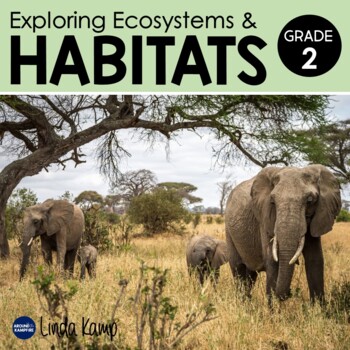Habitats & Ecosystems Second Grade Science Unit - NGSS
- Zip
What educators are saying
Also included in
- This second grade habitats and ecosystems science bundle is an in-depth, 3-week science resource carefully designed with literally everything you need to teach NGSS and many state science standards for 2nd grade Interdependent Relationships in Ecosystems. The unit addresses NGSS 2-LS4-1, 2-LS4.D. ThPrice $27.00Original Price $34.00Save $7.00
- Teaching second grade science aligned with the Next Generation Science Standards is quite challenging without quality resources to guide you. These in-depth units address all 2nd grade NGSS topics and enable you to plan and teach high-engagement, three-dimensional science lessons. The six units in tPrice $105.00Original Price $132.00Save $27.00
Description
This second grade habitats & ecosystems science resource is a comprehensive 3-week science unit carefully designed with literally everything you need to teach NGSS and many state science standards all in one, in-depth resource.
This resource aligns with 2nd grade NGSS Interdependent Relationships in Ecosystems and 2-LS4-1, 2-LS4.D. It includes 15 days of highly engaging science lessons on these topics:
Lesson Topics:
- Identifying Habitats & Ecosystems
- Exploring Land Habitats
- Adapting to Land Habitats
- Exploring Water Habitats
- Adapting to Water Habitats
- Comparing Habitat Diversity
- Habitat Interdependence
- Protecting Habitats
This unit is also available bundled with a digital version and narrated audio lessons HERE.
Each ready-to-teach lesson comes with a highly engaging instructional PowerPoint, detailed, scripted lesson plans, response journal activities, differentiated quizzes, hands-on investigations, and simple lab activities that are actually doable in your classroom.
The lessons also include vocabulary posters, guiding questions, and learning objectives display cards as well as related videos for each lesson. Literacy and math-based science centers make it easy to integrate science and reinforce the lessons during other subjects.
Assessments are easy to differentiate using one of two quiz formats: the fill-in-the-blank option or the short, written response format. At the end of the unit, students are assessed with a comprehensive unit test.
What’s included:
- A complete Teacher’s Guide with a 15-day Pacing Guide that can be shortened to fit your schedule
- Standards alignment pages for each lesson
- Teacher planning binder with cover and sections
- 15 Days of detailed, scripted lesson plans.
- 6 Hands-on investigations with guided lab procedures and step-by-step directions with photos.
- An in-depth Teaching PowerPoint with embedded videos
- Essential questions posters and learning target cards
- Guiding questions & objectives cards
- Student journal/workbook
- Vocabulary cards + full page posters
- 4 Literacy and math-based science centers
- Quizzes for each lesson in 2 formats (short written response or fill in the blank) with answer keys
- Final unit test with optional pages for differentiation
- Easy grade answer keys for all resources
- Related video links
Lab Experiments/Investigations
Students explore micro-habitats, simulate and demonstrate adaptations, build models, and conduct investigations in the following labs:
- What Lives At School? Exploring Micro-habitats
- How Do Fish Breathe Underwater? Gill demonstration
- Build a Model Water Plant
- Design & Build a Land and Water Habitat on a Plate
- How Do Water Animals Stay Warm? Blubber Demonstration
- Comparing Habitat Diversity with simple models
Habitats/Biomes Addressed
Deserts, rainforests, deciduous, coniferous, and temperate forests, grasslands, tundras, oceans, tide pools, coral reefs, wetlands, swamps, marshes, rivers, and streams.
Students explore ecosystems, micro-habitats, and urban habitats. They discover ways ecologists, engineers, and other scientists collaborate to protect and restore endangered habitats.
4 Included Science Centers
Reinforce science content as students practice these math & literacy skills:
- Cause & Effect
- Sorting & Classifying
- Applying Vocabulary
- Math word problems using science content
*Please see the preview for details and pictures of all resources included in this unit.
This unit is included in a yearlong bundle of 2nd grade science curriculum > > CLICK HERE.
CLICK HERE for a list of materials needed to do the labs.
Note: This is a very large unit that downloads as a zipped (ZIP) folder with 3 separate files inside. CLICK HERE for directions to open a ZIP file.
Happy teaching!
Linda Kamp
Around the Kampfire
Click HERE for 3rd grade science units.
Additional 2nd grade science units:
Scientists & The Scientific Method
Plant & Animals Needs and Life Cycles
Landforms Building & Writing Project
2nd grade DIGITAL units with audio lessons:
Scientists & The Scientific Method Digital
Earth Changes & Landforms Digital
Terms of Use © Linda Kamp. This product may not be posted on a public website or shared Drive where others can download it. It may not be used on Outschool or any commercial teaching or tutoring platform. You may not translate or resell this resource.







